Harvesting a Jackfruit is like giving birth!

For those of us who love fruit trees in our landscapes, probably nothing is more exciting than harvesting a Jackfruit. They are the most unusual looking trees you have ever seen. If you have never grown one, or seen one in person, you are missing out.
A friend gave me a seedling tree over 10 years ago, and little did I know what a strange and wonderful tree it would turn out to be. For all the information you need on growing them, please see this EDIS DOCUMENT. In this blog, I want to focus on the daunting task of harvesting them.
When ripe, Jackfruit are the size of a large, oblong watermelon but even heavier.
Determining when a Jackfruit is ripe can be a little tricky, but I always like to keep tapping it until it sounds hollow. Also, when the rind is a little soft here and there, or you can start to smell its distinctive fragrance, then it’s time to cut the cord. (The thick stem reminds me of an umbilical cord.) Don’t wait too long and let it ripen too much or it will fall apart and be ruined. Better to harvest it a little under-ripe and then let it ripen for a few days on the counter.
Remember that it will exude latex as soon as it’s cut, so be careful not to get it on your clothes. It’s best to have a paper towel handy to put over the cut edge while you bring it in. Be sure that you are all set up beforehand. Have a piece of cardboard or an old towel over your table or counter to protect it from the sticky latex. Have several bowls ready: one to receive the rag, which is the covering of the arils, one for the arils, the part that you actually eat and one bowl for the seeds.
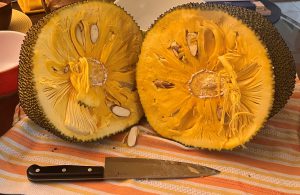
Harvesting a Jackfruit is a time-consuming task, so allow enough time for processing. After you have harvested the edible parts, you will have a lot of great biomass for your worm bin or compost pile, so don’t waste it.
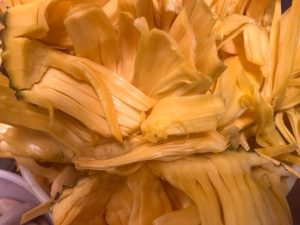
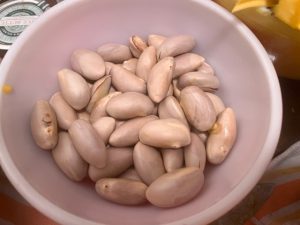
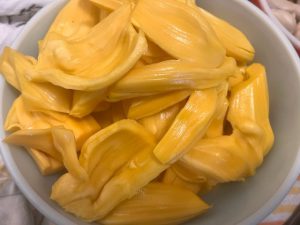
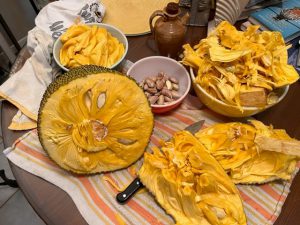
There are so many ways to use both the ripe and unripe Jackfruit.
Do an internet search and you will be amazed at all the different Jackfruit recipes from around the world. There always seems to be something to harvest in South Florida, and for growing tropical fruits, it’s the best. I hope that you give Jackfruit a try.



